


In the arena of a vast New York
sports palace, a man lay dead, murdered during the opening scene of a spectacular rodeo. This mystery is about...
|
|
"Remember. I predicted that “The American Gun Mystery” would be a best
seller? Well, it is." --
Lionel Houser, The Indianapolis Times "A humdinger." -- New York Times "For some reason that is quite beyond me, these Ellery Queen stories have a great vogue among mystery fans. They seem to me pompous, over written and boring, and this one is no exception." -- Bruce Catton, The Indianapolis Times "Queen begins spinning the web of the mystery slowly, speeds up to a whirl of action, and slows down for a final, somewhat complicated solution of the crime." -- The Western Maryland Voice of Industrial Labor "... though somewhat over-written, is ingeniously intricate" -- Scribner's Magazine |
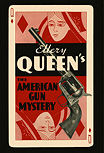 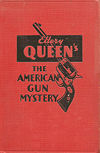   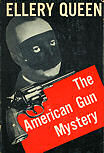   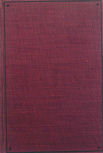 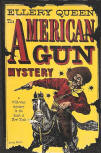 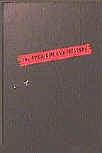 |
| Above: The first books published sometimes had identical front covers. The spine of the books/dust cover only differ in the publisher's logo. Top row left to right: Both dust cover and hard cover for Stokes, Grosset & Dunlap & the dust cover for Triangle Books edition. Bottom row left to right: three hardcover variations for the Triangle Books edition and finally dustcover & hard cover for World Publishing Company, Tower Books edition (Click on the covers to see the differences) * |
| The
Evening Star, Washington D.C., "New Books at Random" by Margaret Germond
- Tuesday, June 13. 1933 "Ellery Queen again offers a problem in deduction which might, so far as its personnel and its action is concerned, have propounded itself for a solution back in the pioneer days of Texas or Wyoming, but which actually projected itself into the present day in no less wild and woolly west a location than New York City. Gathered in the great Colosseum of Tony Mars, promoter of various sorts of entertainment, twenty thousand people were yelling themselves hoarse in approval of the usual stunts which constitute a first-class rodeo performance. Included in that immense throng of humanity were Inspector Queen, his son Ellery and the faithful Djuna, to whose urgent pleas that they take him to see the rodeo they had succumbed. Sitting in the box of the great Tony Mars were other guests besides the Queens and Djuna, among whom were Mara Gay, actress, of Hollywood, and Kit Home, adopted daughter of Buck Horne, one-time fancy rider and shooter, who was being given a chance at a comeback, supposedly by the farseeing and box-office knowing Tony. The time arrives for Buck Horne's appearance in the arena and he is heralded by his old and tried friend, Wild Bill Grant, yelling to the multitudes that the great Buck Horne, followed by forty riders, will furnish the biggest stunt ot the rodeo. Buck rides in, with forty-one instead of forty horses and men beating the sawdust into a cloud behind them, shooting simultaneously at a signal from their leader. An instant after the shooting Buck falls from his horse, shot through the heart. Forty-one riders and twenty thousand spectators, and every one of them a suspect! Not an easy task ahead of the Inspector and his inquisitive son, but they tackle it. A week or so later the rodeo resumes its performances, though the mystery of Buck's death is still un solved. On the opening night, with twenty thousand people again on hand and the same group of guests in the box of Tony Mars, in the identical performance in which Buck lost his life, and at the identical spot in the arena, another rider is shot through the heart with the same revolver which killed the first man. The reader is given an opportunity to identify and to convict, the killer. It is a right big dare even for the most avid of mystery story fans." |
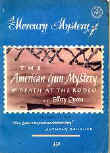 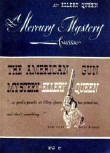   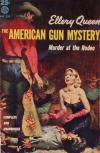     |
|
The American Gun Mystery (1933) is the
sixth Ellery Queen novel, and one of the author’s most
ambitious experiments in transplanting the Golden Age detective story into
an American setting both vast and theatrical. The novel opens in the New
York Colosseum, a sports arena filled with 20,000 spectators, all gathered
to watch Tony Mars’s spectacular rodeo. Among them sit Inspector Queen,
Ellery, and Djuna, alongside Hollywood actress Mara Gay and Kit Home, the
adopted daughter of Buck Horne, a legendary cowboy shooter attempting a
comeback. During the climactic event, Horne rides into the arena followed by
forty other riders—but there are forty-one instead of forty. At the height
of the synchronized gunfire, Buck suddenly falls dead, shot through the
heart before the eyes of the immense crowd. The impossible crime is
immediately framed: forty-one cowboys, twenty thousand witnesses, and yet no
one can identify the killer. |
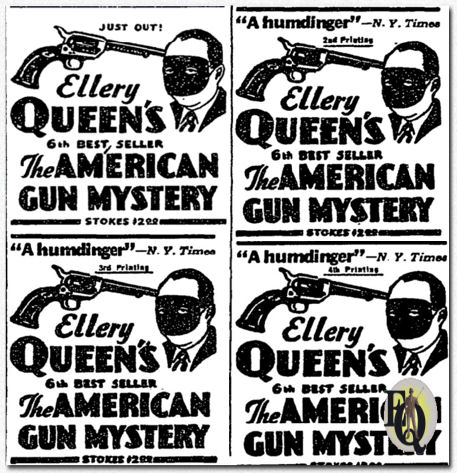 |
|
Above: Ads from four consecutive New York Times
Book reviews in 1933 indicate that Ellery Queen's The
American Gun Mystery was being reprinted every week in its first month
of publication. |
|
Others were far less kind. Bruce Catton dismissed the novel as “pompous,
over written and boring” (Indianapolis Times). The Western
Maryland Voice of Industrial Labor noted that Queen “begins
spinning the web of the mystery slowly, speeds up to a whirl of action, and
slows down for a final, somewhat complicated solution.” The Catholic journal
America praised the fair-play challenge inherent in Queen’s puzzle,
emphasizing how the pamphlet included with the novel underscored the
author’s promise that only one solution and one criminal existed—though
modern critics argue that the novel cheats on the rules of fair play (Michael E.Grost).
|
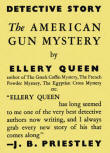 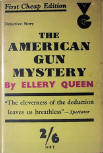 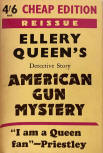 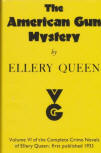  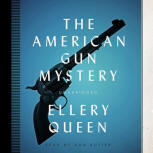   |
| America: A Catholic Review of
the Week -
July 22. 1933 "The Ellery Queen mystery stories seem to be going around the world. So far we have had Egyptian, Greek, Dutch, French, and Roman. Now it’s American and 100-per-cent American in 'The American Gun Mystery' (Stokes. $2.00). A rodeo in the new Colosseum in New York just off Broadway; death rides with the rodeo before the eyes of 20,000 spectators and movie-camera men who without any warning film a murder. Your mystery- story addict has a taste that is easily jaded, over-exacting, and highly critical all at once. For such the author sends along a pamphlet that explains enough of his technique to lay down a fair challenge to the reader. Unraveling the plot then becomes a game, the reader’s wit alert at every turn, confident that the author will play fair, give adequate clues to solve the plot which, he promises, has but one solution and one criminal. Without the candid challenge to match wits the story might not be fully satisfactory or convincing to the honest fan who wants his mystery straight." |
|
Elements for "The Game" With plan and challenge to the reader. Buck Horne is shot with a .25 automatic in N.Y's new Colosseum on Broadway. Dr. Prouty reappears and from the NYPD we get assistance from Thomas Velie, Hesse (blond and stolid), Pigott (thin and shy), Ritter (burly member), Johnson, Inspector Knowles, Hagstrom and Flint. Ellery wearing his pince-nez receives a telegram from Hollywood and sends them a story. |
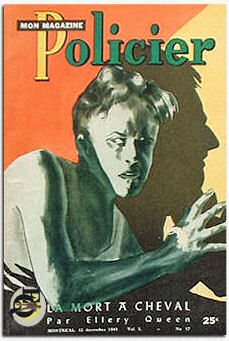 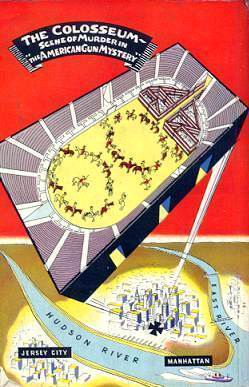 |
|
Above left: French magazine Mon Magazine Policier (Revue Moderne)
published in Montreal, Canada, December 1945. It featured La Mort A
Cheval. Above right: Backcover of the Dell pocket book,, Dell Books 4 Published 1943, 2nd edition 1946 with mapback.* |

|
The American Gun
Mystery Translations: |
|
Other articles on this book (1) Reading Ellery Queen Jon Mathewson (Nov 2013) (2) The Poetry of Ellery Queen Pinakothek (Dec 2, 2008) (3) Mysteries Ahoy! Aiden Brack (May 2019) (4) The Heel of Achilles Ho-Ling (May 14. 2013) (5) My Reader's Block Bev Hankins (November 12. 2021) |
|
*
Interested readers should know
that the icons/covers
of books, used throughout the
website have extra
descriptions/information not
included in the text on the same
page. Pointing your cursor at
the icon/cover used to reveal
this extra information. To achieve the same effect Firefox users can install an add-on called 'Popup ALT Attribute'. When installed pointing your cursor at an icon/cover results in showing you the details or additional information. |
|
Copyright © MCMXCIX-MMXXV Ellery Queen, a website on deduction. All rights reserved. |